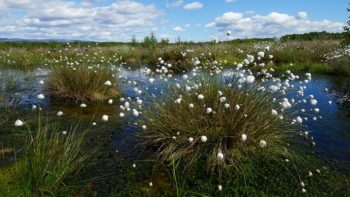New research is utilising satellites to measure “breathing” rates of Scottish bogs to help monitor site conditions and keep an eye on carbon emissions.
Satellite interferometric synthetic aperture radar (InSAR) is being used to map the movement of the ground’s surface – a technique developed with the University of Nottingham spin-out company Terra Motion.
By measuring the motion over time, the technique is able to assess the condition of the peatland and the effectiveness of different restoration techniques on a large scale.
The project is being carried out by NatureScot in conjunction with the University of the Highlands and Islands, the University of Nottingham, as well as Forestry and Land Scotland.
With peatland restoration seen as being important in the fight against climate change, this could provide experts with a better estimate of the amount, distribution and condition of carbon stored in Scotland’s peatlands.
In addition, using satellite tech to measure the surfaces could highlight areas where urgent restoration action is needed.
Commenting on the news, lead author on the research Chris Marshall, peatland scientist at the University of the Highlands and Islands, said: “Bog breathing or peat surface motion gives a unique insight into the inner workings of the peatland, including its landscape, hydrology and ecology.
“However, the high frequency of ESA sentinel-1 imagery and developments in InSAR processing techniques allows us to monitor peatland condition at a scale unimaginable a decade ago, allowing peatland restoration progress to be measured in real-time.
“The techniques developed during this work are now being applied as part of a Leverhulme award to determine how resilient Scotland’s peatlands are to extreme climate events such as wildfire, drought and extreme precipitation events, in order to guide management of these valuable ecosystems during this period of climatic change.”
May Shirkhorshidi, NatureScot’s Peatland ACTION report manager, added: “Peatland restoration is a crucial nature-based solution to the twin crises of climate change and biodiversity loss, a key priority as we look towards the COP26 in Glasgow later this year.
“While in the early stages of development, we are excited about the long-term potential of this research, which could help Peatland ACTION to target priority areas for restoration and offer a scientifically proven way of monitoring changes in peatland condition following restoration.”
According to the research, the method could “provide a better estimate of the amount, distribution, condition and associated carbon inventories of peatlands in Scotland” if developed on a national scale, as well as the “means of assessing the impact of investment” in peatland restoration.
It could also help to identify areas of Scottish bogs at high risk of peat instability, as well as fire and erosion, and highlight where urgent restoration action might be needed.
Shirkhorshidi continued: “This is a really interesting development for all the Peatland ACTION partners as it could help us evaluate the success of different restoration techniques – putting us in a better position to share this knowledge with others.
“Crucially it could allow us to do this more quickly and on a far larger scale across Scotland. We look forward to working with partners over the coming years to develop the concept further.”
Source: DIGIT

